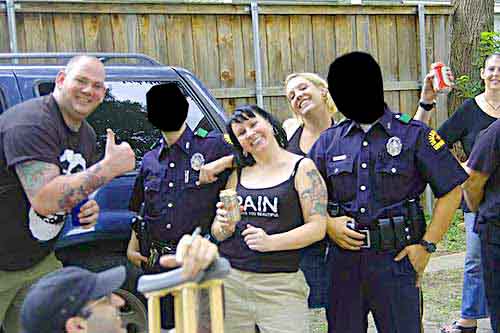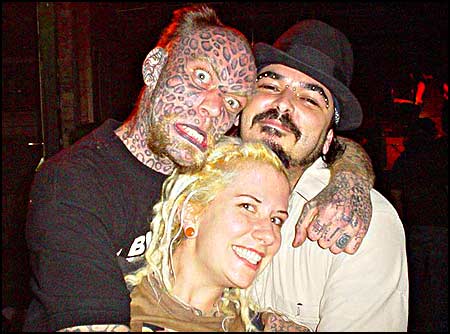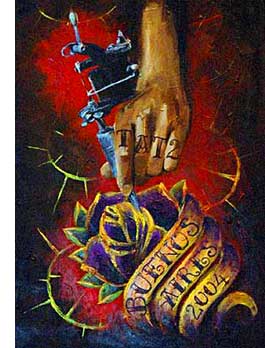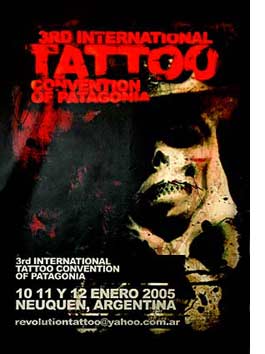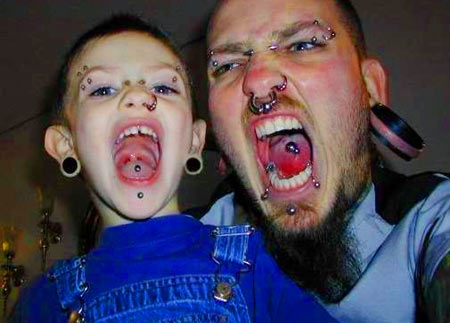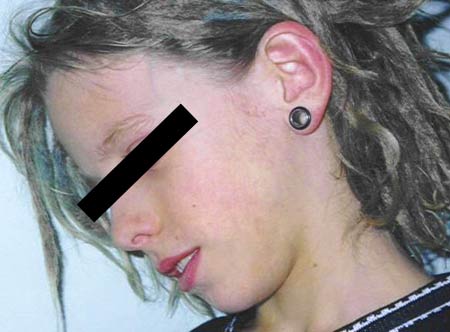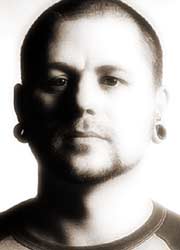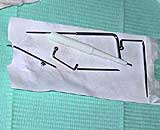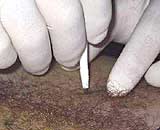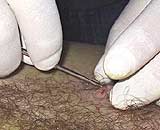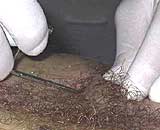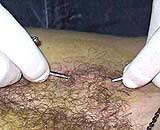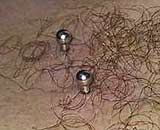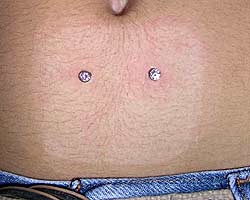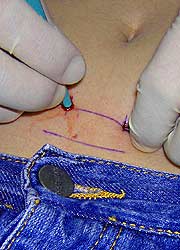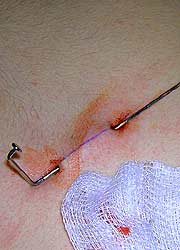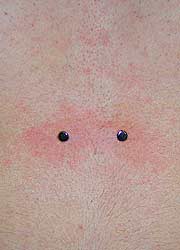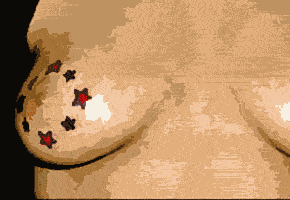
A brief history of BME and reflections on the first ten years |
“Love knows no limit to its endurance, no end to its trust, no fading of its hope; it can outlast anything. Love still stands when all else has fallen.”– I COR 13:7-8
Ten years have passed since BME was first uploaded. In that time it has gone from being one of the first websites on the Internet to being one of the oldest and most successful, not only in body modification, but of all subjects. I have a pretty bad memory, so it’s possible that some of these things are out of order, but let me try and tell you how BME came to be what it is now.
In the summer of 1994 I was at a turning point in my life. On one hand I was building the world’s first Internet casino, was about to be featured in WIRED magazine for it, and had a flagship telephony product that was being hailed as revolutionary. On the other hand, I was fresh out of psychiatric prison, at odds with my family (it was my mother who had me drugged and locked up after I grew up to be “too weird” for her sensibilities), and had just moved back to Toronto. I was living with a stewardess at the time, which gave me a lot of unattended time to myself as I enjoyed her fancy apartment.
I’d always been “online”, but only via the BBSs I accessed using my text-only DOS-based computer. One of the systems I used had a primitive USENET gateway (newsgroups; now Google Groups) which allowed access to rec.arts.bodyart, a discussion group for all things body modification. The BBS I was using only allowed reading, not posting, so after a week or so of monitoring it in silence I set myself up with a full Internet account and “delurked”. One short week after that — August 15th, 1994 — I made the following post:
For a first issue I would like to make a sort-of-FAQ with photos (among other stuff) — something that newbies could ftp and would answer a lot of question — but I don’t want to use magazine pictures so I would need people to mail me pictures or email me scans of stuff... not just finished piercings but procedural photos if you have an unusual piece of pierce. (I will probably use photos of having an 8mm dermal punch put through my conch.)
Response was not very strong, although I did get a few photos, but I think it was luck that made the biggest difference. My ears were stretched to over an inch using homemade jewelry, but I wanted something better. In my search I happened to walk into Stainless Studios where I met Tom Brazda. He’d just hired Ryan Worden (who now runs BMEshop) to run the counter, and in September 1994 hired me to make jewelry, even though I’d never done it before, let alone even operated a lathe. Also working at Stainless Studios was Ryan O’Brien who would later run BMEbooks. In any case, with the help of their customers and portfolio (and my friend Saira’s computer, which was much better than my own), on the evening of December 7th, 1994 I was able to announce BME’s creation.
Newsgroups: rec.arts.bodyart
Date: Tues, Dec 6 1994 10:02 pm EST
Subject: Body Art Magazine / WWW SiteOk, well the magazine is much more on its way! The initial pictures from the first issue are available on my WWW site.
http://www.io.org/~glider
There are a bunch of pictures: hand web, large piercings, stretching, implant surgery, eyebrow... they are 1200dpi colour 24bit scans, all 640x480 in .jpg format — check it out. Text will be there soon too...
shannon larratt
[email protected]
It was amazing how quickly the site grew. As soon as it was up, word started to spread and people started sending in their pictures and stories as well. At this point it was nothing but a few text-only menus with links to images which could be downloaded and viewed later, but bandwidth began to spike — by December 15th it was already clear that female genital piercings drew a server-crushing amount of bandwidth!
Within a few months BME was ranked as the 25th most popular site on the fledgling Internet — of all subjects. As the Internet grew, BME normalized to about 850th of the four billion or so sites now online, but bandwidth continued to grow, cracking a million hits in the first month, and then quickly moving up to a million daily and later twenty million daily! Hosting wasn’t cheap back then, but in another “just got lucky” moment that seems to define BME, one of Internex Online’s employees turned out to be a fan of the site and helped convince her bosses that BME deserved free hosting, which they continued to provide until they were bought out by a larger telecom corporation.
That company wasn’t willing to provide me with free hosting, but they understood the business potential of the volume of readership BME was drawing. We had a series of increasingly unpleasant meetings discussing advertising, memberships, and so on. As luck would have it again, an employee of another small hosting company — Quintessential Communications (now Sound Concept) — offered me hosting under their “FreeQ” banner and with their help was able to stall becoming commercial for a few more years.
Eventually bandwidth bills caught up to Gypsy and Brian at Quintessential, and BME did take advertising, getting early support from companies like Anatometal and Unimax which was essential in keeping BME afloat. At about this time we started adding paid membership options as well, which also started to allow me to dedicate more and more time to maintaining the site and building software tools to improve it. Now that we were paying for our bandwidth usage (which was cripplingly expensive back then, and we often ran at a dramatic loss), BME bounced between ISPs a little to keep costs low, including a few more years with a new company owned by Paul Chvostek, the founder of the company who’d offered us hosting back in 1994!
BME also expanded into BME/extreme with the help of Shawn Porter who I met after the death of body modification pioneer Jack Yount — we officially launched BME/extreme on the first anniversary of Jack’s death. A little later BME/HARD was launched using all the images I’d been getting from people for the first few years that I deemed “too dirty” to use in the main sections. I’d resisted adding them because I didn’t want erotic aspects to dominate the site, but the fact is that erotic application of body modification and play is a significant sociocultural demographic, and it would be contrary to BME’s mandate of accurately representing this community to exclude it any longer. With that decision, BME had matured as a commercial entity and began to be able to stand on its own two feet.
However, BME’s financial growth brought its own problems. The first time we offered online memberships we had virtually no fraud control in place (no one did; it was too early). We were later horrified to discover that we had a fraud rate of about 75%, which instantly destroyed that billing system. I later moved on to Online Financial Systems, an early third-party adult processing competitor to companies like Ccbill (no mainstream billing service would take BME, so we had to work with people processing for pornographic sites). As much as the credit card companies “tolerate” adult sites (because they are profitable), they make life hell for them — increased rates, draconian charge-back policies, aggressive security hold-backs, and so on, and that’s if you can even find a bank willing to take on an adult customer. Most will not. Because of this BME found itself processing out of the Bahamas. The site was making enough money to pay its bills, but then the bank started getting slow on their transfers to us… and slower… “sorry, there’s a technical problem down here… you’ll get the money next month, we’re very sorry…”
After months of charges (as well as a security deposit and a rolling hold-back) had been sequestered in their tropical holding cells, it became clear they’d defrauded us and we had little to no recourse to reclaim it.
It took a few months of negotiations with new banks but eventually BME was back taking memberships — although this cycle of economic abuse would happen several more times, and I expect it to happen several more times in the future. Sometimes all it takes is the wrong person at corporate headquarters to clue in to what BME represents and we find ourselves on the street. That said, every time this has happened, BME has stayed online and continued to run, almost entirely due to generous support from those who create BME through their images and stories. It’s very important to understand that the reason that BME has worked (or at least why I think it’s worked) is because of those people. BME isn’t a magazine with a mandate of its own to push — it seeks not only to be representative of the voice of the community, but to actually be created cooperatively by the community itself.
As much as BME had tools for this community beforehand — a simple forum system, personal ads, and later even online “beauty pageants” — it’s really October 15th, 2000 that needs to be mentioned. The Net was already way into the blogging phenomenon, and I decided I’d like to have an online diary of my own. I put together a simple system for journals, and since it wasn’t really going to be much more work to do so, made it available for others to play with, posting the following message:
October 15, 2000: I am so tired! I probably shouldn’t tell you about it yet, but if you want to see what I’ve been working on, go to http://bme.com/iam/ -- Feel free to play with it if you want to, but do realize that we’re talking pre-Alpha stuff here and I’ve only completed about 25% of the programming. If you do play with it, and you experience “odd” behavior, please do tell me though.
As had happened six years before with the main BME site, IAM quickly snowballed and a vibrant community was there within the week! I added features as quickly as I could and started tying parts of the IAM site and BME together. IAM went through a set of growing pains similar to BME and now continues as (I believe) the defining online body modification community (and a pretty nice piece of software as well).
IAM has been able to provide a backbone of communication and introduction for people, and has helped catalyze tens of thousands of intense friendships, dozens of marriages (and some divorces) and now babies as well (including my own I suppose). In-person meets (echoing back to the rab munches of USENET) are common and from them suspension groups, bands, and more have sprouted. BME has grown from my little one-page website idea to a distributed empire given life by the ideas of hundreds of thousands of creators.
Maybe I’m kidding myself and the reason for BME’s success is simply pictures of female genital piercing as I opined in December 1994, but speaking without misery it’s my opinion that the reason this growth happened is because BME was always run first as a devout offering to something we all believe in, and second as a business. BME’s stated goals are as follow:
- To let people know they are not alone and to help them to understand who they are and what they are going through.
- To provide a space allowing people to share their experiences with body modification and manipulation.
- To politically and commercially encourage the ethical growth of body modification and manipulation.
- To generate revenue and succeed as a traditional business, and to reinvest a part of these profits in body-related projects.
- To educate the public about body modification and manipulation for the purposes of safety, history, culture, and good will.
- When possible, to unify people interested in body modification and manipulation subjects.
- To never judge one body modification or manipulation activity as more “right” than another and never succumb to public (mainstream or non-mainstream) pressure to draw this line.
- To act as a media liaison to encourage accurate portrayals of body modification and manipulation and to encourage positive mainstream acceptance of body modification and manipulation activities.
- To work with other body modification and manipulation groups to further our common goals.
While I’ve left a lot out in this brief history — the creation of BMEshop, Uvatiarru (our movie), all the BMEbooks productions, legal fights, HUSTLER offering to buy BME, constant content theft, threats, ModCon, the Church of Body Modification, BME/Japan and much more — but that brings us basically up to date.
Reflecting on Ten Years
So… ten years of my life have been used on this project. I estimate I’ve spent at least 30,000 hours of time building and maintaining the site (and that’s my “lower limit” estimate). Was it worth it? Absolutely. As time has gone by I have become convinced of one thing:
“We are right.”
That is, the way that we live is the right way for us to be living (I make no claim that there aren’t other paths up the mountain, but for me, and many people reading this, this is the right path for us). The things we do and the things we document on BME, almost universally, are good, in the purest sense of the word. They bring us joy, they expand and enrich our lives and horizons, they help us view the universe through larger eyes, they feel good and make us feel good about ourselves, they teach us and they help us talk — and all without hurting anyone else. Yet millions of dollars in resources are dedicated to enacting laws to ban our practices and to ban us from even talking about them, and trillion-dollar corporations do everything they can to make operating businesses on the subject hellish. My wife and I even risk prosecution and imprisonment in countries close to our hearts due to being BME’s publishers.
Why would the power players of modern society so resist the oldest form of human art and expression? It’s simple and disturbing: we are an affront to conformity, the conformity they need to maintain their power structure.
Let’s be real clear on something. The average person is an idiot. So blank and malleable in fact that the stranger telling them for a few seconds what to do — or what to buy — will be heeded. Don’t believe me? Explain advertising. The simple fact that advertising exists is all the proof you need to know that the vast majority of people are sheep. If this were not true, advertising would be based exclusively on the comparative merits of the product, which we all know is not the case. It’s one of those “can’t see the forest for the trees” scenarios — because of the abundance of ads, most of us don’t see their real message revealing the pathetic nature of most humans.
By definition, a person with piercings or tattoos — or who likes to shove a football up their rectum (damn near killed ’em!) — is breaking the rules and unable to believe that the status quo applies to them. The more they engage in body modification and play the more they realize that the status quo is a myth, that happiness really does come from within, and that life is what you make it — not what you pay someone else to make it. Thus we, the modified, are dangerous to them. It’s no lie that many of us have experimented with “risky behavior” as we are accused — because we don’t accept their rules. Because we want to know for ourselves. Because we desire to take an active role — or an active roll — in life.
I could go on and on with statistics to prove it (and have done so on my IAM page), but one of the things that has been revealed within the last four years of political turmoil is how far removed the average person’s worldview is from reality. At this point not much over 10% of Americans believe in the concept of evolution any more, and polling has showed that adherence to these views are deeply linked to political allegiance — or, to put it another way, the average person believes what they’re told to believe, not what they observe or understand to be true. Not only that, but the average person not only does not want to discover the truth for themselves, but they become openly hostile when that truth is expressed to them, and violent if it is presented alongside difficult to refute evidence.
People who “break the rules” by doing things like abnormally* modifying their physical form take a step toward rejecting this idealogical control structure. Because of this we have ridiculous and hypocritical laws restricting body modification,
or pushing it back far enough into adulthood that it is less able to be a formative experience. Those at the upper end of the power structure do not want those below them realizing the power structure is illusory — so they combine a two pronged attack of restricting growth at the edges while dumbing down and bulk-marketing that which they can’t stop. Body modification and other fringe lifestyles are treated with a mix of derision, restrictive legislation, lampoonery, and finally watered-down price-slashed mainstreaming.
Society is made up of 99% sheep, 0.9% goats, and 0.1% wolves. Before I get into that though, let me just rewind to the Janet Jackson nipple piercing fiasco and the other recent obscenity fines in America. What you may not know about these is that as much as obscenity is defined by “community standards”, only a handful of people actually find these materials obscene — in the $1.2 million dollar fine handed to FOX over Married by America, only three letters were written to the FCC complaining. Three.
![]() Maybe right now you’re asking yourself why FOX would accept the largest fine in broadcasting history for something that offended only three people out of millions of viewers (I’m quite certain that everything on TV offends at least three people). Simple answer — it was a $1.2 million campaign contribution to help convince Middle America that we — the freaks — were closing in on them. And it worked — they had a knee jerk reaction, called for “moral values”, and TV censorship is at an all time high in America, and liberties are being rolled back across the nation… including a reconsideration of whether tattooing and piercing should be legal — including even documenting it as on BME. Sometimes they do this with outright bans, but normally they do it with soft bans involving ridiculous and unfeasible health or zoning requirements. What’s happening is clear though — a tiny number of people are manipulating the group mind in order to suppress the vocal minority who aren’t connected to the enslaved and unquestioning Borg Collective paying the richest people in the world to stay rich.
Maybe right now you’re asking yourself why FOX would accept the largest fine in broadcasting history for something that offended only three people out of millions of viewers (I’m quite certain that everything on TV offends at least three people). Simple answer — it was a $1.2 million campaign contribution to help convince Middle America that we — the freaks — were closing in on them. And it worked — they had a knee jerk reaction, called for “moral values”, and TV censorship is at an all time high in America, and liberties are being rolled back across the nation… including a reconsideration of whether tattooing and piercing should be legal — including even documenting it as on BME. Sometimes they do this with outright bans, but normally they do it with soft bans involving ridiculous and unfeasible health or zoning requirements. What’s happening is clear though — a tiny number of people are manipulating the group mind in order to suppress the vocal minority who aren’t connected to the enslaved and unquestioning Borg Collective paying the richest people in the world to stay rich.
But getting back to animal land, it is the job of the goats to have fun, explore the borders, occasionally eat a tin can, and try and let the sheep know that just because “sheep” and “sheep herd” use the same spelling on their root word doesn’t mean that they’re conceptually the same thing. Sure, you’re a tribe member, but you’re also an individual. Then you’ve got the wolves, who live off the sheep. The job of the wolves is to keep the heard healthy but beat down enough to make easy victims, while killing any goat that gets too uppity.
Speaking as a lunatic who buys this metaphor, I’d like to think that BME reminds the wolves that the goats actually enjoy kicking, don’t really mind if their lip gets pierced by that risky tin can, and point out to some of the sheep that if they’d like to take on the goat role, they’re perfectly welcome to do so. I’m looking forward to ten more years of kicking wolves, and partying with risk-enamored converted sheep and all my goat friends. If a wolf kills me, which is certainly quite likely, at least I’ve died honorably… but I’d like to keep telling everyone that it’s OK to break the rules because the rules are a myth. I’d like to keep telling people that any way you want to live is fine and the more doors inside yourself you want to open the better. I want to keep broadcasting everyone’s transformative stories so they can reach as many people as possible.
Before I finish, I have one last — and most important — thing to say to everyone: Thank you for your help. I think we have done a good job together, and have expressed something wonderful. Here’s to ten (thousand) more.

Shannon Larratt
BME.com
















